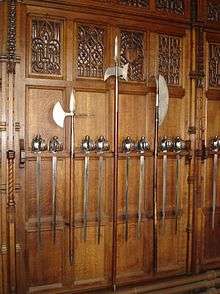Lochaber axe


The Lochaber axe is a type of halberd that was used almost exclusively in Scotland.
Specifics of the weapon
The Lochaber axe is first recorded in 1501, as an "old Scottish batale ax of Lochaber fasoun".[1]
The weapon is very similar to the Jedburgh axe, although the crescent blade of the former is larger and heavier than that of the latter.[1] The Lochaber axe took many incarnations, although all of them had a few elements in common. It was a heavy weapon, used by infantry for a defence against cavalry and as a pike against infantry. Like most other polearms of the time, it consisted of two parts: shaft and blade. The shaft was usually some five or six feet (1.5 or 1.8 m) long, and mounted with a blade of about 18 inches (45 cm) in length which usually resembled a bardiche or voulge in design. The blade might be attached in two places and often had a sharp point coming off the top. In addition a hook (or cleek) was attached to the back of the blade. A butt spike was included as a counterweight to the heavy axe head. Langets were incorporated down each side of the shaft to prevent the head from being cut off.
Use
In hand-to-hand combat, the axe, in common with other polearms such as the halberd, has a spike on the end, to be used on close combat in a thrusting motion. The axe on the side, coupled with the long pole, delivered a powerful blow to infantry or dismounted cavalry.
The rear-facing hook of a Lochaber axe is too small to have been used to pull a person. In later examples of the weapon, particularly those used by the city guards of Edinburgh, the hook is almost level with the top of the staff, making them useless as a means to catch a moving object. These hooks, however, may have been used to hang the weapons in the guard room.[1]
Citations
- 1 2 3 Waldman (2005) pp. 195–197.
References
- Waldman, J (2005). Hafted Weapons in Medieval and Renaissance Europe: The Evolution of European Staff Weapons between 1200 and 1650. History of Warfare (series vol. 31). Leiden: Brill. ISBN 90 04 14409 9.